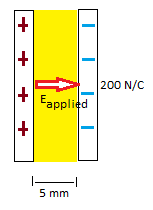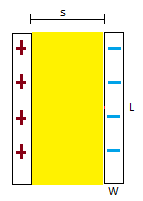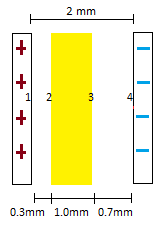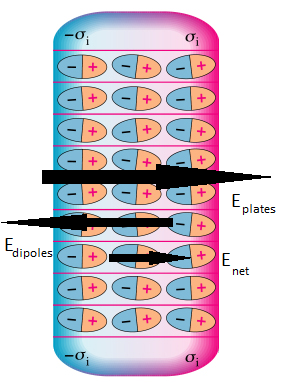Potential Difference in an Insulator: Difference between revisions
Connorbrogan (talk | contribs) |
Connorbrogan (talk | contribs) |
||
| Line 148: | Line 148: | ||
https://www.nde-ed.org/EducationResources/HighSchool/Electricity/conductorsinsulators.htm | https://www.nde-ed.org/EducationResources/HighSchool/Electricity/conductorsinsulators.htm | ||
http://www.physics.utah.edu/~woolf/2220_buehler/electricpotential.pdf | http://www.physics.utah.edu/~woolf/2220_buehler/electricpotential.pdf | ||
Matter and Interactions, 4th Edition by: Ruth Chabay and Bruce Sherwood | |||
[[Category:Fields]] | [[Category:Fields]] | ||
Revision as of 02:07, 2 December 2015
Potential difference is defined as a scalar quantity that measures the difference of energy per unit charge. This page will not go over how to calculate electric potential in a conductor (because other pages cover this topic), but rather, how to find the electric potential in an insulator given the potential difference in a vacuum.
Potential Difference
Although this section will not go in depth into how to calculate potential difference, the following analysis requires the knowledge that potential difference equals the dot product of the electric field vector and distance vector between two points. Understanding that potential difference is dependent on the distance between two points is an important prerequisite to comprehending how to find the potential difference inside an insulator.
Net Electric Field Inside an Insulator
Between two points inside a metal object in equilibrium, the potential difference is zero. However, this is untrue for an insulator that is polarized by an applied electric field (such as that inside a capacitor). In order to quantitatively predict the potential difference between two points in an insulator, we first must understand how this applied electric field polarizes molecules in the surrounding objects. Typically, this electric field creates induced dipoles inside the insulating materials. These induced dipoles contribute their own electric field to the net field. Because dipoles create such a unique pattern of electric field, it is slightly more complex to find the electric field and potential difference inside the insulator.
The net electric field inside the insulating material is the sum of the applied electric field (often due to a capacitor) and the electric field produced by the induced dipoles. The field from the induced dipoles always points in the direction opposite to the applied electric field (as shown in Diagram 1). Consequently, the net electric field is in the direction of the applied field/capacitor, but it is weaker in magnitude.
Dielectric Constant
When solving for the potential difference in an insulator, we define the constant K as the dielectric constant. This quantity represents the amount by which the net electric field is "weakened" due to the induced dipoles. It is a value typically known through previous scientific experimentation (specifically, measuring the effect of an insulator on the potential difference between two charged objects).
A Mathematical Model for the Electric Field Inside an Insulator
[math]\displaystyle{ \vec {E}_{insulator} = \frac{\vec{E}_{applied}}{K} }[/math]
The dielectric constant K is always bigger than one if an insulator is present because the induced dipoles in the polarized insulator always weaken the net electric field. When an insulating substance is easy t polarize, K will be large because the induced dipoles will create a weaker net electric field. If there is no insulating material between the charged objects (the space is a vacuum), K equals one.
Relating Electric Field to Potential Difference
Because the relationship between the electric field and potential difference is proportional, potential difference will also decrease by a value K. That is, placing an insulator in between two charged objects like the plates of a capacitor also decreases potential difference across the insulator. It is important to note that if the insulator does not fill the gap between objects, the electric field and potential difference inside the insulator are still reduced by a factor K. However, the areas that are not filled by the insulator are not affected since the electric field inside the insulator is negligibly small.
A Mathematical Model for the Potential Difference Inside an Insulator
[math]\displaystyle{ \Delta{V}_{insulator} = \frac{\Delta{V}_{vacuum}}{K} }[/math]
Examples
Be sure to show all steps in your solution and include diagrams whenever possible
Simple
A capacitor is known to create a uniform electric field of magnitude 200 N/C. The capacitor plates are 5mm apart. A plastic slab (whose dielectric constant is 5) is carefully inserted into the gap between the capacitor. Calculate the potential difference across the insulator.

Step 1: Find [math]\displaystyle{ \Delta{V}_{vacuum} }[/math]
[math]\displaystyle{ \Delta{V}_{vacuum} = E●\vec{dl} }[/math]
[math]\displaystyle{ \Delta{V}_{vacuum} = 200*\frac{5}{1000} }[/math]
[math]\displaystyle{ \Delta{V}_{vacuum} = 1 V }[/math]
Step 2: Use the potential difference in a vacuum and the dielectric constant to find the potential difference in the insulator.
[math]\displaystyle{ \Delta{V}_{insulator} = \frac{\Delta{V}_{vacuum}}{K} }[/math]
[math]\displaystyle{ \Delta{V}_{insulator} = \frac{1}{5} }[/math]
[math]\displaystyle{ \Delta{V}_{insulator} = 0.2V }[/math]
The potential difference inside the plastic slab is 0.2 V.
Middling
 A capacitor's left plate has charge +Q. It's right plate has charge -Q. As shown in the diagram, the plates are separated by a distance s. Both plates have a length L and a width W. An insulator with dielectric constant K is inserted into the gap. Find the potential difference across the capacitor.
A capacitor's left plate has charge +Q. It's right plate has charge -Q. As shown in the diagram, the plates are separated by a distance s. Both plates have a length L and a width W. An insulator with dielectric constant K is inserted into the gap. Find the potential difference across the capacitor.
Step 1: Find the electric field of the capacitor.
[math]\displaystyle{ {E}_{capacitor} = \frac{Q/A}{\epsilon_0 } }[/math]
[math]\displaystyle{ {E}_{capacitor} = \frac{Q/LW}{\epsilon_0 } }[/math]
Step 2: Find the potential difference across the capacitor if there was no insulator.
[math]\displaystyle{ \Delta{V}_{vacuum} = E●\vec{dl} }[/math]
[math]\displaystyle{ \Delta{V} = \frac{Q/LW}{\epsilon_0}*s }[/math]
Step 3: Use the dielectric constant to find the potential difference across the insulator.
[math]\displaystyle{ \Delta{V}_{insulator} = \frac{\Delta{V}_{vacuum}}{K} }[/math]
[math]\displaystyle{ \Delta{V}_{insulator} = \frac{Q/LW}{\epsilon_0}*\frac{s}{K} = \frac{Qs}{LWK\epsilon_0} }[/math]
Difficult
 A capacitor originally has a potential difference of 500V. The capacitor plates are 2mm apart. A 1mm thick plastic slab (whose dielectric constant is 5) is inserted into the gap between the capacitor, but it does not fill the gap. It is placed 0.3mm from the positively charged left plate and 0.7mm from the negatively charged left plate. Calculate the following potential differences: [math]\displaystyle{ {V}_{1}-{V}_{2} }[/math], [math]\displaystyle{ {V}_{2}-{V}_{3} }[/math], [math]\displaystyle{ {V}_{3}-{V}_{4} }[/math], and [math]\displaystyle{ {V}_{1}-{V}_{4} }[/math].
A capacitor originally has a potential difference of 500V. The capacitor plates are 2mm apart. A 1mm thick plastic slab (whose dielectric constant is 5) is inserted into the gap between the capacitor, but it does not fill the gap. It is placed 0.3mm from the positively charged left plate and 0.7mm from the negatively charged left plate. Calculate the following potential differences: [math]\displaystyle{ {V}_{1}-{V}_{2} }[/math], [math]\displaystyle{ {V}_{2}-{V}_{3} }[/math], [math]\displaystyle{ {V}_{3}-{V}_{4} }[/math], and [math]\displaystyle{ {V}_{1}-{V}_{4} }[/math].
Step 1: Find [math]\displaystyle{ {V}_{1}-{V}_{2} }[/math]
Originally, the potential difference in the capacitor is 500V. We must solve for the electric field in the capacitor (without the insulator) first. [math]\displaystyle{ E = \frac{\Delta{V}}{\vec{dl}} = \frac{500}{0.002} = 250000 N/C }[/math]
Because the insulator is not present in the area between points 1 and 2, we can find the potential difference from point 1 to point 2 by multiplying the electric field by the distance between points.
[math]\displaystyle{ \Delta{V} = E●\vec{dl} }[/math]
[math]\displaystyle{ {V}_{1}-{V}_{2} = 250000*.0003 = 75V }[/math]
Step 2: Find [math]\displaystyle{ {V}_{2}-{V}_{3} }[/math] In order to find this quantity, we must first find the potential difference that would occur in a vacuum. To do this, we take the electric field we found in step 1 and multiply by the distance.
[math]\displaystyle{ \Delta{V} = E●\vec{dl} }[/math]
[math]\displaystyle{ \Delta{V} = 250000*.001 = 250V }[/math]
Next, we must use the dielectric constant of plastic to find the potential difference in the insulator.
[math]\displaystyle{ \Delta{V}_{insulator} = \frac{\Delta{V}_{vacuum}}{K} }[/math]
[math]\displaystyle{ {V}_{2}-{V}_{3} = \frac{250}{5} = 50V }[/math]
Step 3: Find [math]\displaystyle{ {V}_{3}-{V}_{4} }[/math]
Because the insulator is not present in the area between points 3 and 4, we can find the potential difference from point 3 to point 4 by multiplying the electric field by the distance between points.
[math]\displaystyle{ {V}_{3}-{V}_{4} = E●\vec{dl} = 250000*0.007 = 175V }[/math]
Step 4: Find [math]\displaystyle{ {V}_{1}-{V}_{4} }[/math]
In order to find the potential difference between points 1 and 4, we simply need to add up the potential differences found in steps 1-3.
[math]\displaystyle{ {V}_{1}-{V}_{4} = 75V + 50V + 175V = 300V }[/math]
Connectedness
Understanding insulation is particularly important in fully comprehending circuits and electricity. Although not used as commonly in experimental entry-level physics (such as Physics 2211 or 2212) as elements of circuits like capacitors and resistors, insulators have a more practical application. As evidenced by several of the examples on this page, the potential difference across an insulator is always significantly less than through a vacuum. Because they do not let electric charge flow easily from one atom to another, insulators are used to coat wires in order to protect human users from the dangerously high voltage produced by some electric current.
History
Potential difference is a phenomenon that was first discovered by Alessandro Volta, an Italian physicist who lived from 1745 to 1827. Through his work with Luigi Galvani, Volta detected the flow of electric current through various conducting materials. This led to the discovery of electromotive force (what we more commonly refer to as emf) and eventually allowed Volta to create the first battery. Slightly later, Georg Ohm, a German physicist, began studying Volta's research. Through experimentation, Ohm was the first to uncover the relationship between the potential difference applied through a conductor and the resultant electric current. These findings and scientists were the most crucial to discovering the relationships between current, resistance, electric field, and voltage/potential difference.
See also
In order to more fully understand potential difference in an insulator, a basic understanding of potential difference through a vacuum is necessary. These other Physics Book Wiki pages should further one's understanding of this topic.
Potential Difference in a Uniform Field
Potential Difference Path Independence
External links
https://www.youtube.com/watch?v=TFGpgfe3Q2g
http://physics.bu.edu/~duffy/semester2/c08_dielectric.html
References
http://www.physics.sjsu.edu/becker/physics51/capacitors.htm https://www.nde-ed.org/EducationResources/HighSchool/Electricity/conductorsinsulators.htm http://www.physics.utah.edu/~woolf/2220_buehler/electricpotential.pdf Matter and Interactions, 4th Edition by: Ruth Chabay and Bruce Sherwood
-cbrogan7
